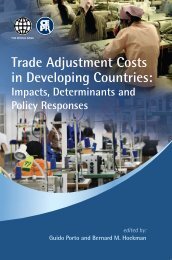Download PDF - Vox
Download PDF - Vox
Download PDF - Vox
- No tags were found...
You also want an ePaper? Increase the reach of your titles
YUMPU automatically turns print PDFs into web optimized ePapers that Google loves.
The G20MAP, global rebalancing, and sustaining global economic growthThe world is now in a more complex position that it was immediately after the crisis,and cooperation is now much more difficult. Interest rates are at their zero bound. And,because of the high levels of public debt, there is little fiscal space.China is rebalancing its growth model towards one in which there is a more rapidexpansion of domestic demand. But China is necessarily doing this at a slow speed(Yongding 2009). During this period of adjustment the dollar-renminbi real exchangerate will continue to be one which leads to East Asia having a large export surplus. Atthe same time, world interest rates are too low for China, which continues to attempt todeal with this difficulty with capital controls.Europe is in danger of re-creating the global problem at the European level (Vines2010, 2011a). Countries in the southern European periphery are now embarking ondemanding austerity programmes. The difficulty of adjusting wages and prices in thesecountries of the periphery, which are greatly uncompetitive vis-à-vis Germany, createsa need for the euro to depreciate, so as to encourage growth in these countries. At thesame time, the German economy is difficulty because European interest rates need tobe low. The position in Germany would become even more unbalanced if the euro wereto depreciate further.And the US is caught in a fiscal trap. The inability of the US political system to promiselonger-term fiscal correction has made it difficult to for the US to sustain its shorter-termfiscal stimulus. The resulting fiscal withdrawal is part of the reason why unemploymentseems likely to remain so persistent in the US.Many activities in the US are now globally uncompetitive because of the depreciatedreal exchange rates of China and of other East Asian countries. The outcome may wellbe one in which the US wishes to have a lower real exchange rate against not justEast Asia, but against Europe as well. Quantitative easing has become a tool whichinfluences the dollar in this direction. But many activities in the European periphery arealso globally uncompetitive, because of the depreciated real exchange rate of Germany19














